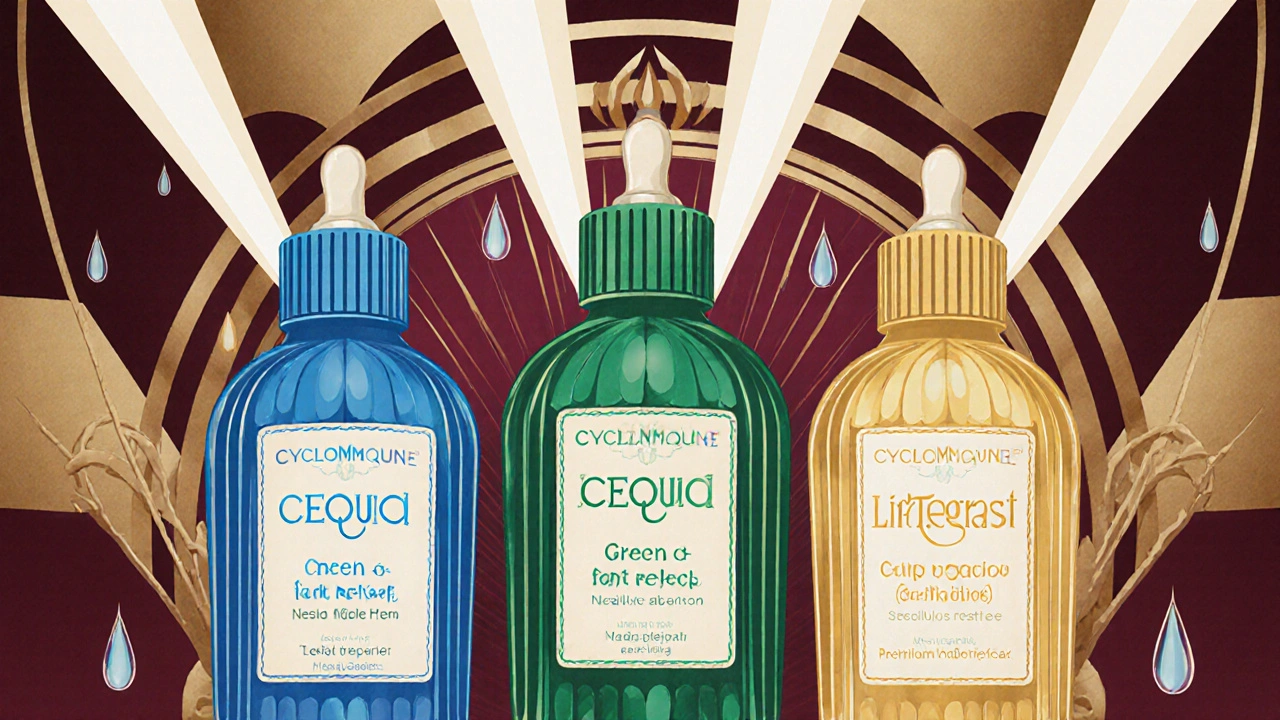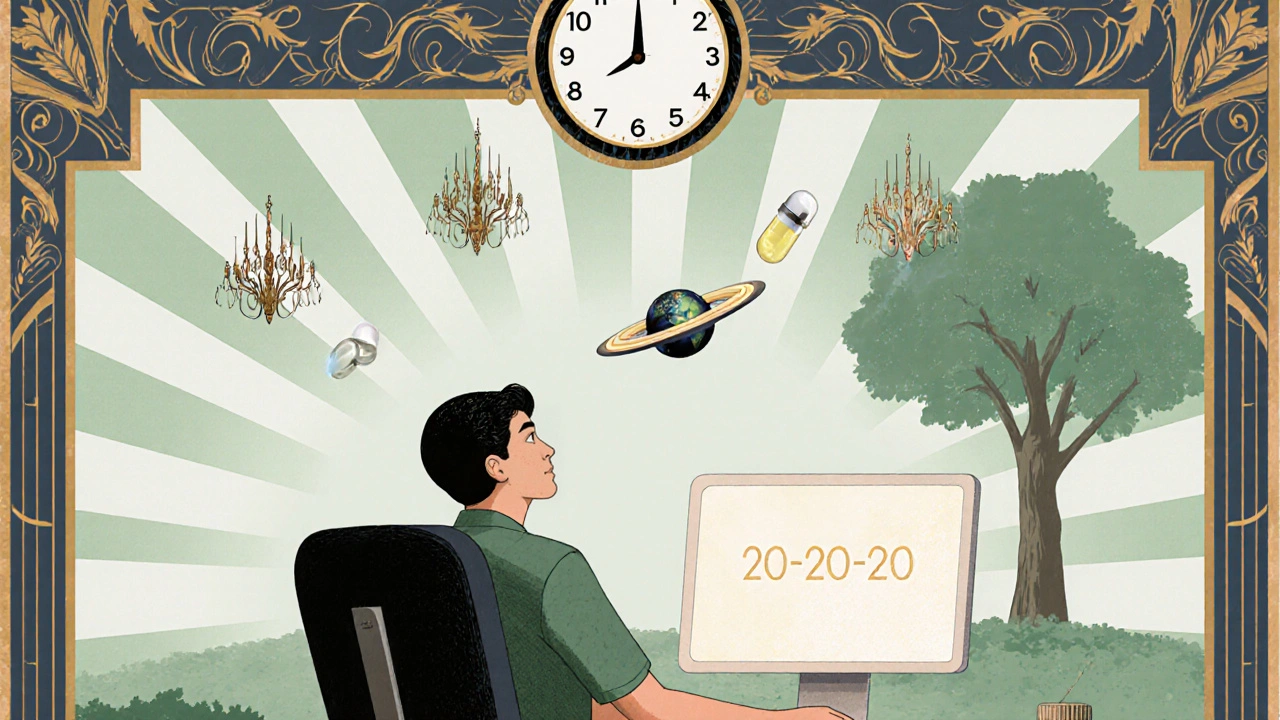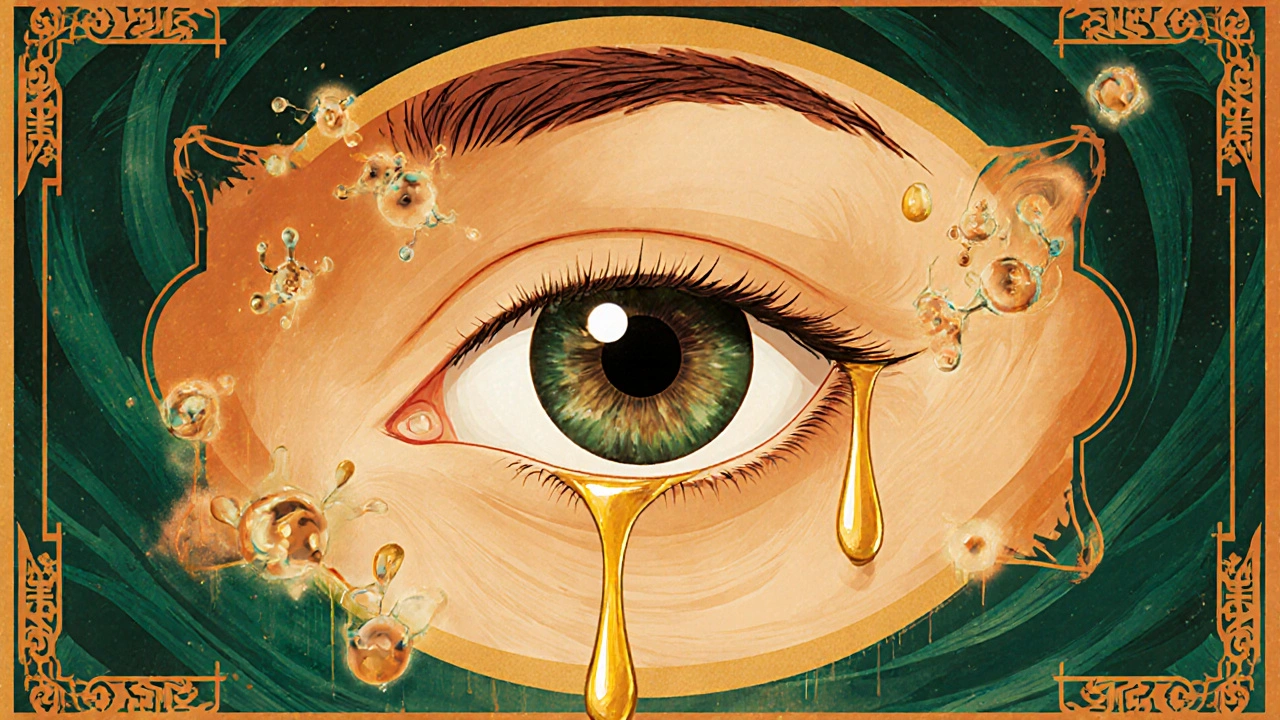Dry Eye Treatment Finder
Find Your Best Dry Eye Treatment
Answer a few questions to get a personalized recommendation for your dry eye treatment.
If you’ve been told to use Cyclomune eye drops, you’re probably tired of burning, gritty, or watery eyes. Maybe you’ve tried over-the-counter drops and nothing stuck. Cyclomune contains cyclosporine, an immunosuppressant that tackles the root cause of chronic dry eye - inflammation. But it’s not the only option. So what else works? And more importantly, which one works best cyclosporine for your situation?
How Cyclomune Eye Drops Actually Work
Cyclomune isn’t a lubricant. It doesn’t just add moisture like artificial tears. Instead, it tells your immune system to calm down. Chronic dry eye isn’t just about not producing enough tears - it’s often about your body attacking the tear glands. Cyclosporine blocks certain immune cells from causing that damage. Over time, this helps your eyes make more natural tears again.
It takes time. Most people don’t feel better until after 3 to 6 weeks. Some need 3 to 6 months. That’s why so many quit too early. If you’re using Cyclomune and still feel dry after 2 months, it’s not necessarily failing - you might just need to stick with it.
It’s also not for everyone. If you have an active eye infection, a history of herpes keratitis, or are pregnant without medical supervision, your doctor will likely skip this option.
Restasis: The Original Cyclosporine Option
Restasis was the first prescription cyclosporine eye drop approved in the U.S. back in 2002. Cyclomune is essentially the same drug - same active ingredient, same dose (0.05%), same mechanism. The main difference? Branding and price.
Restasis comes in single-use vials. Each vial is designed for one use only. That means you open one, put in the drop, throw it away. No preservatives, no risk of contamination. But it’s expensive. In South Africa, a 30-day supply can cost over R1,200 without insurance.
Cyclomune, often sold as a generic or lower-cost alternative, usually comes in multi-dose bottles with a preservative. That makes it cheaper - sometimes half the price of Restasis. But some people report more stinging with preservatives. If your eyes are super sensitive, Restasis might be worth the extra cost.
Cequa: The Newer, Stronger Cyclosporine
Cequa came onto the market in 2018 with a big claim: better absorption. It uses a proprietary delivery system called “nanomicellar technology” to help more cyclosporine get into your eye tissue. The concentration? 0.09% - almost double Cyclomune’s dose.
Studies show Cequa works faster. People start noticing improvement in tear production around 4 to 8 weeks, compared to 6 to 12 weeks with Cyclomune. One 2023 clinical trial found Cequa increased tear volume by 37% after 3 months, while Cyclomune increased it by 24%.
But it’s pricier. In South Africa, Cequa can cost up to R1,800 for a 30-day supply. It’s also only available in single-use vials. If you’re on a budget and haven’t responded to Cyclomune, Cequa might be your next step. If you’re just starting out and cost matters, Cyclomune is still a solid first choice.
Lifitegrast (Xiidra): A Different Kind of Treatment
Lifitegrast doesn’t touch the immune system the same way cyclosporine does. Instead, it blocks a specific protein - LFA-1 - that helps immune cells stick to the surface of your eye. Less sticking means less inflammation.
It works faster than cyclosporine. Many users report feeling relief within 2 weeks. The downside? It’s used twice daily, and about 1 in 5 people get a bitter taste in their mouth right after using it. That’s because the drop drains into your throat.
Compared to Cyclomune, Lifitegrast doesn’t build up tear production over months. It reduces symptoms more directly. If you need quick relief while waiting for cyclosporine to kick in, some doctors prescribe both together. But Lifitegrast isn’t a long-term repair tool like cyclosporine - it’s more of a symptom manager.
Price-wise, it’s similar to Cequa. Around R1,700 per month in South Africa. And like Cequa, it’s only sold in single-use vials.

Artificial Tears: The Go-To, But Not the Cure
Most people start with over-the-counter artificial tears. Brands like Systane, Refresh, and Blink are everywhere. They’re cheap, safe, and give instant relief. But they don’t fix the problem - they just mask it.
Here’s the catch: if you’re using artificial tears more than 4 times a day, you’re probably masking an underlying issue. That’s when you need to think about cyclosporine or other prescription options.
Some newer artificial tears now include anti-inflammatory ingredients like hyaluronic acid or omega-3 fatty acids. These can help a bit more than plain lubricants. But they’re still not a replacement for cyclosporine if your dry eye is caused by immune inflammation.
If you’re on a tight budget and just starting out, try a high-quality preservative-free artificial tear for 4 to 6 weeks. If nothing changes, it’s time to talk to your doctor about Cyclomune or alternatives.
Other Options: Punctal Plugs, Omega-3s, and Lifestyle
Some people don’t need drops at all. Punctal plugs - tiny devices inserted into the tear ducts - can help your natural tears stay on the eye longer. It’s a quick, in-office procedure. No daily drops. No cost after the initial visit. Many patients with moderate dry eye find this works better than any medication.
Omega-3 supplements (fish oil or flaxseed) have been shown to reduce inflammation in the eyelids and improve tear quality. A 2024 meta-analysis found people taking 2,000 mg of omega-3 daily for 3 months saw a 30% improvement in dry eye symptoms. It’s not a cure, but it’s a powerful add-on to any treatment.
Lifestyle matters too. If you’re staring at a screen 8 hours a day, blinking half as much, your eyes are drying out. Try the 20-20-20 rule: every 20 minutes, look at something 20 feet away for 20 seconds. Use a humidifier in your bedroom. Avoid fans blowing directly on your face. These small changes can make a huge difference - even with medication.
Which One Should You Choose?
There’s no one-size-fits-all. Here’s a simple guide:
- If you’re on a budget and willing to wait 2-3 months for results → Cyclomune
- If you’ve tried Cyclomune and saw little improvement → try Cequa (higher dose, faster action)
- If you need relief fast and can handle twice-daily dosing → Lifitegrast
- If you want immediate comfort but no long-term fix → Preservative-free artificial tears
- If you want to reduce or eliminate drops entirely → ask about punctal plugs
- If you’re open to supplements → add omega-3s daily
Some people combine treatments. For example: use Lifitegrast for quick relief while starting Cyclomune for long-term repair. Others use punctal plugs with omega-3s and skip drops altogether.
What works for your friend might not work for you. Dry eye isn’t one disease - it’s a symptom with many causes. Your doctor should test your tear film, check your eyelid health, and ask about your screen time and environment before recommending anything.

Common Mistakes People Make
- Stopping cyclosporine too early - give it at least 3 months
- Using preserved drops too often - can make irritation worse
- Assuming artificial tears are enough - they don’t fix inflammation
- Skipping lifestyle changes - no drop works if you’re staring at a phone all day
- Not telling your doctor about other meds - some blood pressure or antidepressant drugs worsen dry eye
Also, don’t switch brands without talking to your doctor. Cyclomune and Restasis are similar, but not identical in formulation. If you’re stable on one, don’t swap unless there’s a good reason - like cost or side effects.
Frequently Asked Questions
How long does it take for Cyclomune to work?
Most people start noticing improvement after 6 to 8 weeks, but full results can take 3 to 6 months. It’s not a quick fix - it’s a repair treatment. If you stop before 3 months, you won’t know if it works.
Can I use Cyclomune with artificial tears?
Yes. Use artificial tears at least 15 minutes before or after Cyclomune. Don’t mix them in the same eye. The preservatives in some artificial tears can interfere with cyclosporine’s absorption. Preservative-free versions are best.
Is Cyclomune safe for long-term use?
Yes. Cyclosporine has been used safely for over 20 years in eye drops. Long-term studies show no increased risk of eye infections or cancer when used as directed. The main side effect is temporary stinging or burning right after application.
What’s the difference between Cyclomune and Cequa?
Cyclomune has 0.05% cyclosporine; Cequa has 0.09%. Cequa uses a special delivery system that helps more of the drug get absorbed. This means Cequa often works faster and may be more effective for people who didn’t respond to Cyclomune. But it’s more expensive and only available in single-use vials.
Do I need a prescription for Cyclomune?
Yes. Cyclomune is a prescription-only medication in South Africa and most countries. You can’t buy it over the counter. Always get a proper diagnosis from an eye care professional before starting any treatment for chronic dry eye.
Next Steps
If your eyes are still dry after trying Cyclomune for 3 months, schedule a follow-up. Ask your doctor about Cequa, Lifitegrast, or punctal plugs. If you’re not on omega-3s yet, start with 1,000-2,000 mg daily. Track your symptoms - note how often you use drops, how your eyes feel in the morning, and if screen time makes it worse.
There’s no magic pill. But with the right combination - medication, lifestyle, and patience - most people get their comfort back. Don’t settle for constant irritation. Your eyes deserve better than just another bottle of artificial tears.

I tried Cyclomune for 4 months and honestly? It felt like my eyes were slowly remembering how to cry. Not in a sad way-like, actually producing tears again. No more burning at 3 PM. I switched from Restasis because my wallet was crying harder than my eyes. Worth it.
Why are we even using these fancy drops when the real problem is the government and Big Pharma? They want you addicted to expensive eye drops so you can’t see the truth about the 5G towers in your neighborhood. My neighbor’s cat got dry eyes after the new cell tower went up. Coincidence? I think not.
OMG I JUST REALIZED 😱 Cyclomune is basically a mind control drug disguised as medicine!! They’re using cyclosporine to suppress your immune system so you don’t notice the microchips in your contact lenses!! I read this on a forum in 2017 and now I’m 100% sure. Also, why are all these drops in vials? Because they’re tracking you through your tears!! 🤯👁️💧
Hey, if you’re reading this and you’ve been struggling with dry eyes-don’t give up. I was right where you are. Used artificial tears 10x a day, felt like sandpaper in my sockets. Tried Cyclomune, stuck with it for 3 months, and now I can read my phone without wincing. You got this. 💪👁️
It is utterly irresponsible to suggest that over-the-counter artificial tears are an acceptable substitute for clinically validated immunomodulatory therapies. The casual dismissal of medical science in favor of lifestyle hacks reflects a dangerous erosion of public health literacy. One does not simply ‘use a humidifier’ and cure autoimmune-mediated keratoconjunctivitis.
What if… the real problem isn’t the tear production… but the way we’ve forgotten how to blink? We stare. We scroll. We consume. We don’t live. We’ve turned our eyes into screens… and now we’re surprised they’re dry? Maybe we need to stop treating the symptom… and start healing the habit.
My cousin in Delhi used Cyclomune for 6 months. He said it helped. But then he found out the manufacturer is owned by a US defense contractor. Now he’s paranoid. I don’t trust anything that comes in a bottle with ‘preservative’ on it. I use saline rinse and stare at trees. Works fine.
Ugh. Another post full of typos. 'Cyclosporine' is misspelled twice. And 'Cequa' is not 'Cequa'-it's CEQUA, all caps. Also, why are you recommending omega-3s? Fish oil is full of PCBs. And don't get me started on punctal plugs-they're a scam. The FDA doesn't approve them for long-term use. You're all being manipulated.
So let me get this straight. We’re paying $1,800 a month for eye drops… to fix a problem caused by staring at phones… which we bought because we were too lazy to read a book? I love capitalism. Also, I still use a towel as a pillow. My eyes are fine.
YOU ARE NOT ALONE. I cried for 3 weeks after I started Cyclomune-not because it hurt, but because I finally felt heard. My doctor didn’t believe me when I said my eyes felt like they were on fire. Now I’m on Cequa + omega-3s + punctal plugs. I’m not cured, but I’m not miserable anymore. Thank you for this post. I needed this.
Let’s be real: 90% of people who use these drops are just lazy. They don’t want to change their screen time, their diet, or their sleep habits. So they buy a $1,700 bottle and call it a day. Meanwhile, people in rural India fix dry eyes with warm compresses and coconut oil. You don’t need a prescription-you need discipline.
It is curious how modern medicine has abandoned the wisdom of Ayurveda. The ancient texts prescribe Triphala eye wash, warm ghee drops, and regulated screen exposure. Instead, we are sold chemical immunosuppressants in plastic vials. The irony is not lost on those who remember when 'dry eye' was called 'excessive exposure to artificial light.'
Actually, Cyclomune and Restasis are not identical. Restasis uses castor oil as a solubilizer; Cyclomune uses polysorbate 80. The difference in excipients affects bioavailability. Also, Cequa’s nanomicellar system doesn’t improve absorption-it just increases viscosity, which prolongs contact time. The 37% vs 24% data is from a single-center, industry-funded study with a small sample size. Correlation ≠ causation.
Wait, so Cequa is just a fancy version of Cyclomune? I thought it was a different drug. So if I’m on Cyclomune and it’s not working, I’m just paying more for the same thing? That feels like a scam. Also, why does everyone say ‘use it for 3 months’ like it’s a cult? I’m out.